The supervisor of the Nasa support team seeing the crew into the Challenger space shuttle on the launch pad at Cape Canaveral had a very special present for one of the seven — a red apple for the most famous teacher in the world.
Bubbly, auburn-haired, girl-next-door Christa McAuliffe, a smiley social studies teacher from Concord, New Hampshire, had been selected from some 11,000 applicants to be the first civilian in space — a stunt intended to revive flagging public interest in space exploration by making it seem accessible to ordinary people.
The plan was for her to teach two 20-minute lessons from the shuttle, transmitted live to Earth from orbit. One, titled The Ultimate Field Trip, would conclude with a five-minute Q&A with her class back in Concord.
She would also conduct six science demonstrations recorded on video and distributed by Nasa to an audience of 18.5 million U.S. schoolchildren.
As a public relations exercise, the Teacher In Space Project was already a massive hit. Some 800 journalists — twice as many as usual — had signed up to be at the Kennedy Space Center in Florida for the launch. The world was watching, just as excited as Christa at this new giant step for mankind.

US space chuttle Challenger lifting off in January 1986 from a launch pad at Kennedy Space Centre
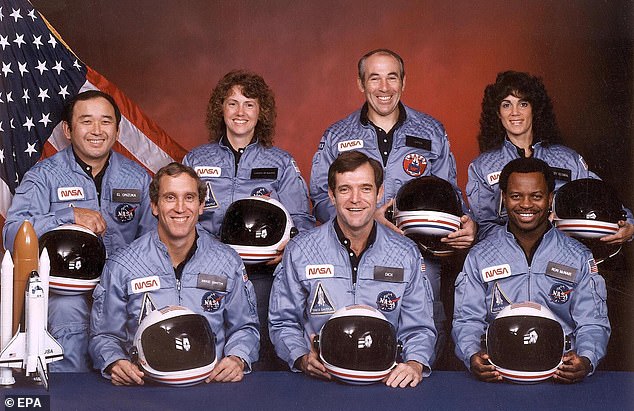
The crew of the Challenger space shuttle, which exploded 72 seconds after take-off:(L-R front row) Astronauts Mike Smith, Dick Scobee, Ron McNair and (L-R, rear row) Ellison Onizuka, school teacher Christa McAuliffe, Greg Jarvis, and Judith Resnik
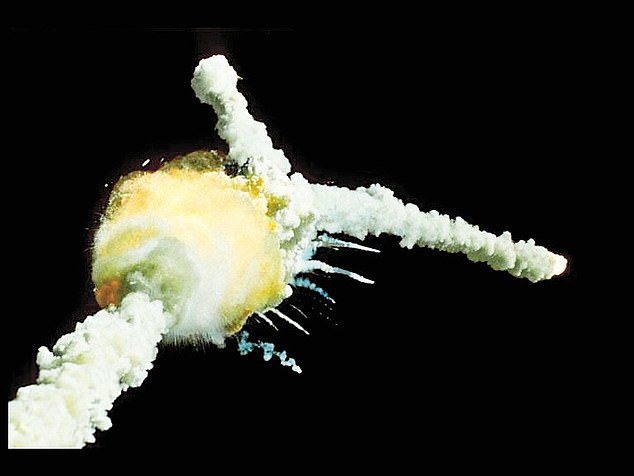
The shuttle was more than four miles up when flames exploded and and destroyed the space craft. The entire crew were killed
McAuliffe took the proffered apple and raised it to her face with a smile, then handed it back. ‘Save it for me,’ she said. ‘I’ll eat it when I get back.’
She never got the chance. The hatch was closed and the countdown was under way for the 25th space shuttle flight in a programme of reusable space transport that, on the morning of January 28, 1986, was into its fifth year.
Inside, harnessed flat on their backs in unyielding aluminium seats, lay the flight deck crew — Commander Dick Scobee, pilot Mike Smith, Judy Resnik and Ellison Onizuka — and beneath them on the lower deck Ron McNair, Greg Jarvis and McAuliffe.
They lay there as the two solid-fuel booster rockets, to which the shuttle was attached, kicked into life and six million pounds of thrust rattled through every nut, bolt and fixture inside the spacecraft. They had lift-off, clearing the gantry.
‘Go, you mother,’ Smith said as the shuttle accelerated towards the speed of sound. ‘S*** hot!’ called out Resnik as the Challenger’s computers increased engine power and it hurtled into space at almost 1,500mph.
For all of 73 seconds. And then…
The shuttle was more than four miles up when flames could be seen licking the side of the right-hand booster rocket. A plume of liquid hydrogen burst into the slipstream and ignited.
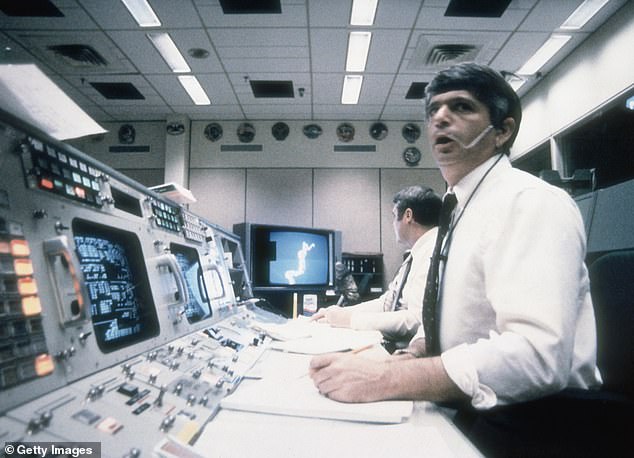
Frederick Gregory (pictured) watching helplessly as the shuttle exploded just moments after leaving the ground
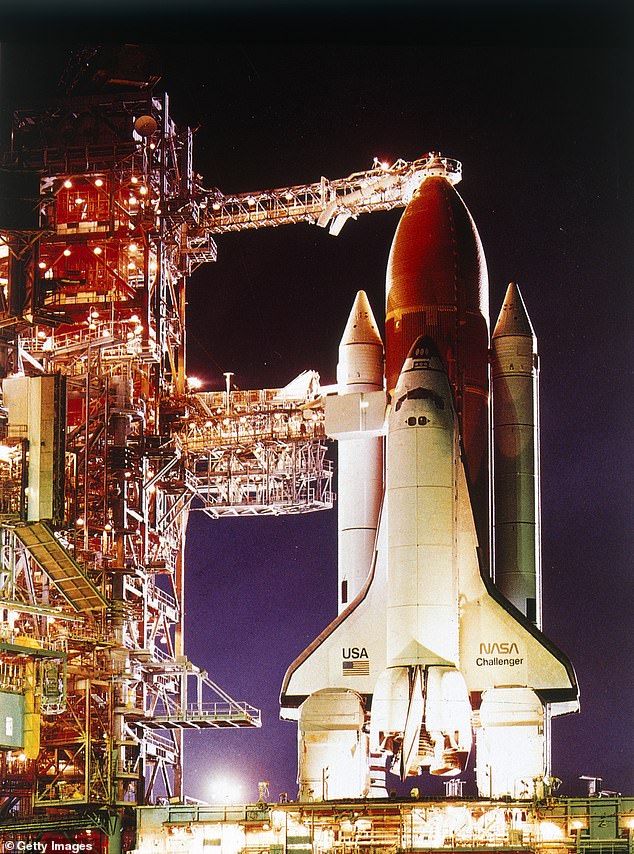
The Challenger on its launch pad minutes before take-off. It was part of a programme in operation from 1983 to 1986 and structural failures led to its explosion
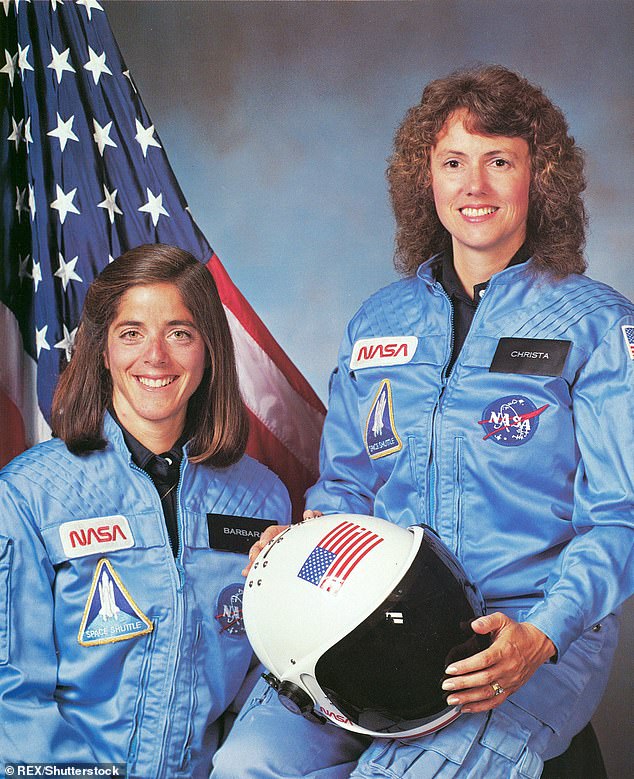
Barbara Morgan, an Idaho elementary school teacher and Christa McAuliffe, a New Hampshire teacher. Barbara was a back-up crew member and survived the fatal explosion but Christa sadly died
The millions on Earth watching what was supposed to be another Nasa triumph couldn’t believe their eyes as Challenger was engulfed in a ball of orange and white flames, a swelling cloud of combustible propellant.
The booster rockets tore free from their mounts and the most complicated machine in history began to disintegrate in flight. Its stubby wings ripped away, the cargo bay burst like a paper bag and the fuselage broke apart.
‘The effing thing blew up,’ was all one cameraman could say in utter disbelief. All radio and data transmission from the flight-deck stopped suddenly.
America went into a state of shock as it took on board the spectacular loss of seven lives, on camera, in front of their families, as well as the massive blow this tragedy meant for the space programme. Plans for shuttles to plant commercial satellites in orbit, to develop space tourism, to push frontiers, had gone up in flames.
A distraught President Ronald Reagan cancelled his annual State of the Union address and from the Oval Office told his nation: ‘The crew of the Challenger honoured us by the manner in which they lived their lives.
‘We will never forget them, nor the last time we saw them, this morning, as they prepared for their journey and waved goodbye and slipped the surly bonds of Earth to touch the face of God.’
He pledged to maintain the shuttle programme. ‘We’ll continue our quest in space,’ he said. ‘There will be more shuttle flights and more shuttle crews and, yes, more volunteers, more civilians, more teachers in space. Nothing ends here; our hopes and our journeys continue.’
But what went unsaid — as was later discovered and is now spelt out in a superb new book by leading investigative reporter Adam Higginbotham — is that the Challenger disaster was an accident that had been waiting to happen for some time.
Critics of the space shuttle programme were becoming increasingly vocal, concerned at the huge cost of what was now a fleet of four craft (Columbia, Challenger, Discovery and Atlantis) but with an uncertain and unspecified financial return.
Faced with arguments that it was all a giant waste of money to no good purpose, Nasa’s response was to ramp up the number of launches, with 15 planned over the coming 12 months.
The agency was taken over by ‘go fever’ — the desperate drive to launch and stay on schedule, regardless of any problems.
Corners were cut, eyes taken off the ball, warning signs ignored and caution thrown to the wind in the desperate drive to make the programme a success so that it would continue to attract taxpayers’ funding.
The idea behind the shuttle was sound enough, exciting and imaginative even — a winged orbiter vehicle that could be blasted into space, and then return to Earth to be used again, made commercial sense.
The possibilities were endless. But there would prove to be a crucial design fault.
Two rockets 150ft high, giant segmented metal cylinders packed with a rubbery compound of volatile fuel, blasted the shuttle off the launch pad and upwards. Higginbotham likens them to massive fireworks, and once lit they could not be throttled or shut down but continued firing until they burnt out.
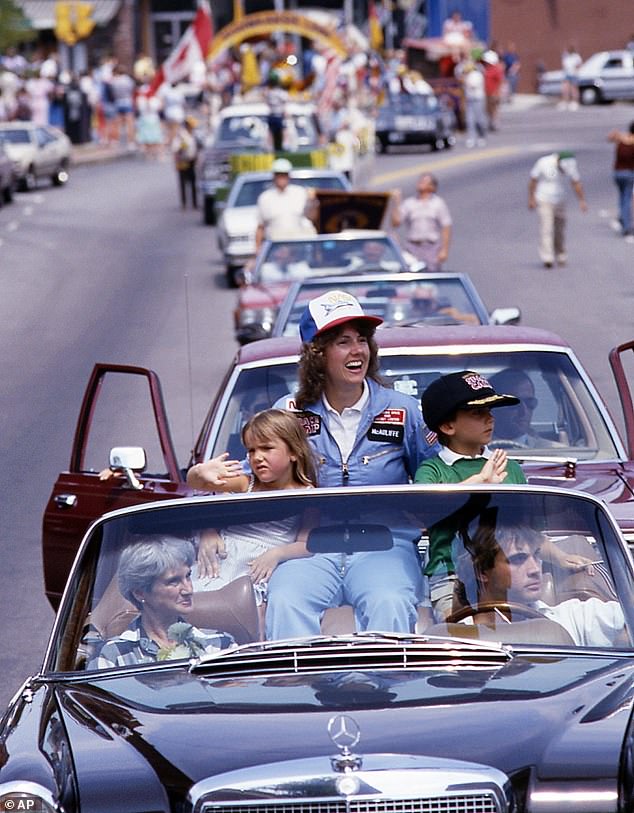
Christa riding along with her children Caroline and Scott during a parade to celebrate the space shuttle
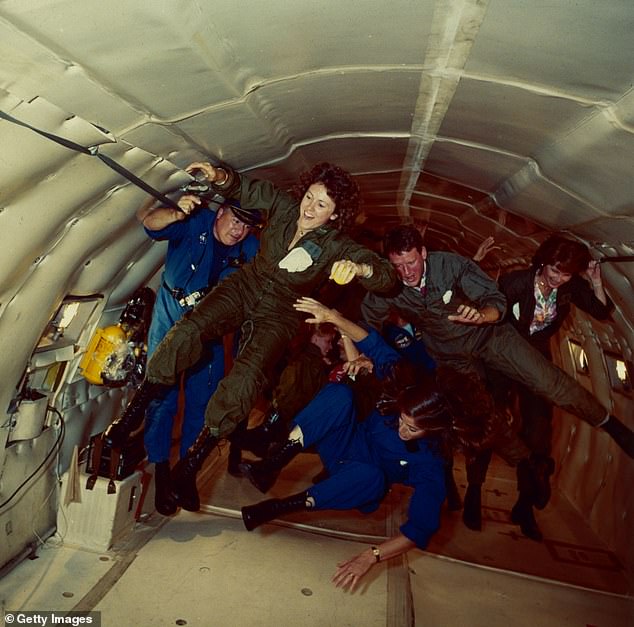
Members of the crew experiencing weightlessness ahead of the launch in a research craft
For two minutes they gave the shuttle its vital initial boost, before dropping off on parachutes into the sea while the rest of the shuttle carried on into space.
Constructed by the aerospace firm Morton Thiokol in Utah, each rocket consisted of separate segments of steel tubing filled with fuel and bolted together, the joints sealed with a pair of rubber gaskets — O-rings — and packed with flameproof, asbestos-filled putty.
If the joints failed and flame escaped, there was every possibility of an uncontrolled explosion.
And the uncomfortable fact was that, on the quiet, those joints had been failing. After the second shuttle launch in 1981, when the ditched booster rockets were reclaimed from the sea for recycling, tell-tale scorching was first found inside those joints, indicating that, with the initial upward thrust, highly combustible gases had leaked through the putty and vaporised parts of the rubber seals.
The response of engineers at Thiokol was to fine-tune the way the joints were assembled in the hope that this would solve the problem.
And for three years, as the number of successful shuttle flights mounted, the joints did their job.
But then, with the tenth flight in January 1984, the original problem returned. Post-flight tests showed that hot gas was once again leaking through the putty and damaging the seals when the rockets were ignited on the launch pad.
But so far the O-rings had held, although sometimes only just, and with no one willing to halt the shuttle programme for modifications that might have spelt the end of the whole project, a judgment was made that the risk was acceptable while a solution was sought.
At the centre of the research at Thiokol was experienced rocket engineer Roger Boisjoly, and he had a theory — that air temperature was crucial to how the seals worked.
He conducted tests showing that, as the temperature dropped, the rubber O-rings became hard and inflexible, making it increasingly difficult for them to do their job.
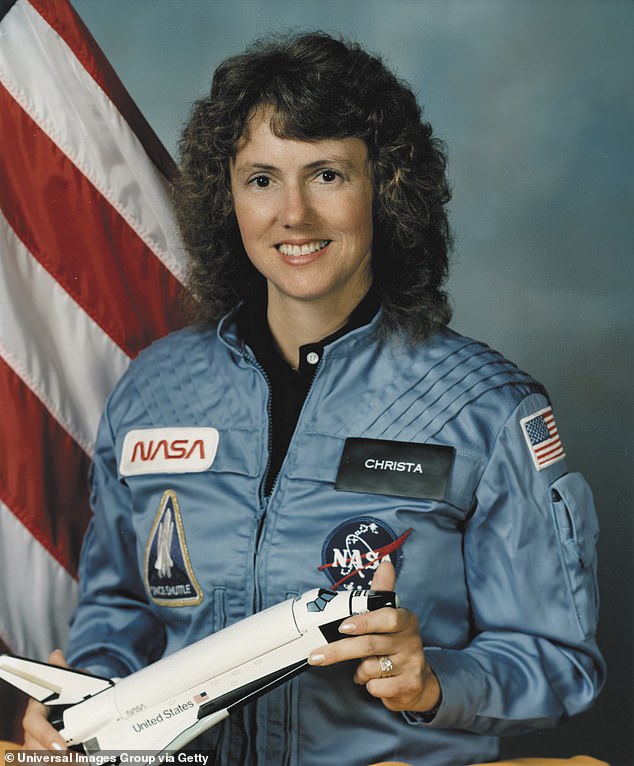
Christa tragically died on the launch. At 11.38am, Challenger’s rockets fired and seconds later the shuttle disintegrated in a colossal fireball, killing all on board
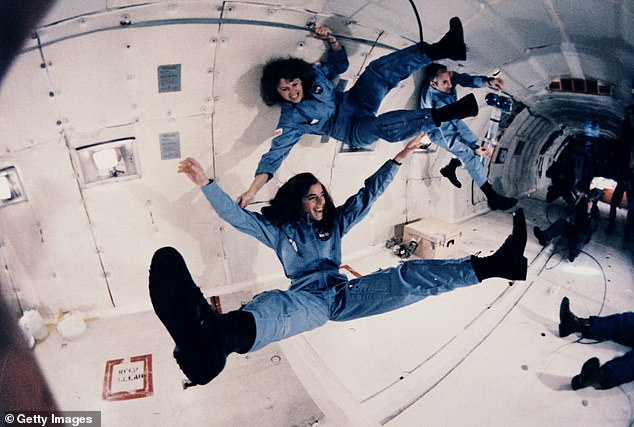
Members of the crew preparing themselves for the space mission by experiencing zero gravity
At 100F (38C), the rubber was soft and flexible and sealed the joint easily. But as it got colder, the O-ring became so inflexible that if a gap opened between the metal halves of the joint at lift-off, a leak could begin and burn through the casing of the rocket.
But when Boisjoly reported the test results to his managers, and his fears that in low temperatures before launch the seals were practically useless, he was told to keep the data to himself.
He went to work sketching out 30 different potential new designs for the joint in question, but no one in management seemed interested. He grew angry and frustrated.
Down in Florida on January 27, 1986, Challenger was close to its latest lift-off, despite conditions that were descending into Boisjoly’s worst nightmare. That day was unusually cold, temperatures plummeting to well below freezing in a once-in-100-year weather event.
Hearing this, Boisjoly convinced his colleagues at Thiokol that, though his data was scant and inconclusive, there was enough doubt that they must recommend postponing the flight.
In a drawn-out, three-way long-distance conference call from Utah on the night before the scheduled launch, he told Nasa bosses they should not take the risk.
He detailed how the O-ring material lost its elasticity in the cold, changing from a malleable sponge to something more like a brick.
He told them that if the primary O-ring didn’t seal within the first 600 milliseconds after ignition, then it was highly likely the secondary seal would be destroyed before it had a chance to close the gap.
In this situation, hot gas would escape through the outside casing of the rocket and the spacecraft would explode.
His recommendation was that the shuttle should be launched only when the air temperature was 53F (11.5C) or higher.
As he wrapped up, Boisjoly was confident he had made a strong case for postponing the launch and that good sense would prevail among the Nasa managers — after all, the safety of the astronauts remained the top priority of everyone involved in the shuttle programme.
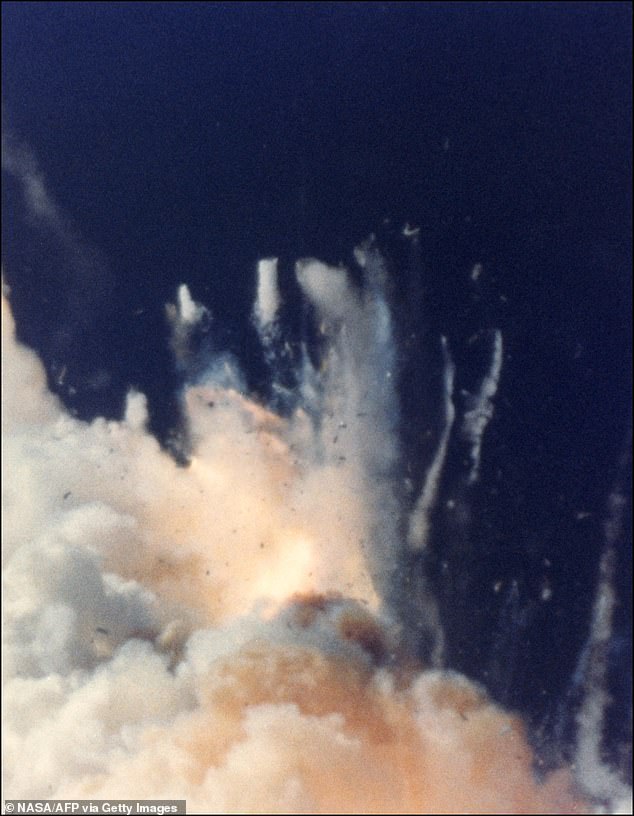
It’s often assumed that the seven must have died instantly, that mercifully it was all so fast they can have known nothing about what was happening to them. It now turns out this is wrong
He felt sure that, at the last possible minute — and despite being able to produce only limited evidence — he had ensured that the countdown presently under way would be stopped. The seven astronauts scheduled to fly aboard Challenger in just a few hours would be stood down and launch another day.
But Nasa’s hugely experienced rocket manager Lawrence Mulloy was having none of it, disputing that air temperature was a significant factor.
The data was simply inconclusive, he argued, and was reluctant to put schedule considerations aside on what he saw as flimsy evidence.
‘When do you expect me to launch,’ he demanded to know. ‘Next April?’ Others in the team came to his support, arguing that Thiokol was trying to change the rules for launching without adequate justification.
Suddenly, the Thiokol team was on the back foot and feeling the pressure. The company’s billion-dollar contract to build booster rockets for the shuttle could well be in jeopardy if they insisted the flight was delayed or cancelled and Nasa’s crowded flight schedule disrupted.
Boisjoly repeated his conviction that the cold posed a real threat to flight safety — it was a not a risk worth taking, the launch must be halted. But Thiokol’s management team overruled him on the grounds that, though there had been erosion in the O-rings, if the primary seal failed, they could always rely on the secondary one.
Jerry Mason, general manager of Thiokol Space Division, took a management decision. ‘Based on all the evidence that’s presented to me, I think that we should go ahead and launch.’
One by one, the other executives fell in line. They told Nasa it could go ahead and launch. Unusually Nasa insisted on having Thiokol send the authorisation to do so in writing.
It was shortly before midnight when the decision was made. Eight hours later, after breakfasting on steak and eggs, the Challenger crew left their quarters, the eyes of the world on them.
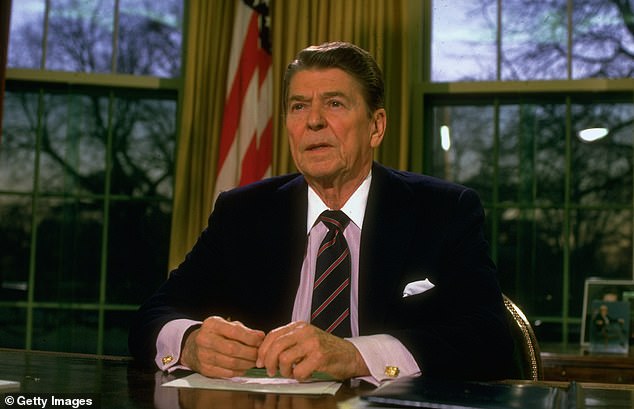
President Ronald Reagan addressed the nation from the White house after the tragic disaster
Out on the launch pad, temperatures had reached their lowest shortly after dawn, falling to 24F, eight degrees below freezing.
A bitter wind had sliced in over the Atlantic and ice settled on the catwalks around the upright shuttle. Icicles hung from handrails and walkways.
It was impossible to predict what would happen if thousands of fragments of ice were sent ricocheting from the gantry when the shuttle engines lit. ‘It’s a bit of Russian roulette,’ an engineer said, adding: ‘But five out of six times you make it, playing Russian roulette.’
The seething cold had crept into everything: the gantry elevator had become sluggish; remote cameras had stopped working; sheer cascades of ice now descended from near the top of the launch tower.
‘Looks like something out of Doctor Zhivago,’ said an onlooker, fully expecting the launch to be scrubbed.
Temperature readings around the shuttle produced odd results: at the bottom of the right-hand booster rocket, the reading on a hand-held thermometer was just 8F — an astonishing 24 degrees below freezing. The engineers who recorded it assumed the thermometer was malfunctioning and said nothing.
It took little more than 20 minutes for the astronauts to cover the nine miles to the launch pad where Challenger lay waiting for them, fully fuelled and ready to depart.
As the high-speed lift carried them up the launch tower, the crew could hear their ship come to life, the external tank heaving and groaning as its thin aluminium skin contracted in the cold, exhaling a stream of boiling liquid oxygen from its conical tip.
When the doors slid open at their destination on Level 195, Commander Scobee announced: ‘This is a beautiful day to fly.’
Even so, as they crossed the swing arm towards the room that gave access to the shuttle, they were warned about the treacherous slick of ice on the walkway.
Resnik shivered in her thin flight suit — but the mood was buoyant as they knelt to crawl into the orbiter. She turned to McAuliffe and said: ‘The next time I see you, we’ll be in space.’
A technician aide moved from one member of the crew to another, tightening their harnesses, completing headset communication checks and adjusting cables and hoses, before exiting. The hatch closed with a bang, and the latches fell into place. Over in the Launch Control Center, the ground controllers broke into a round of applause.
At 11.38am, Challenger’s rockets fired and seconds later the shuttle disintegrated in a colossal fireball, killing all on board.
It’s often assumed that the seven must have died instantly — that mercifully it was all so fast they can have known nothing about what was happening to them.
It now turns out this is wrong.
When the wreckage was found in the Atlantic and salvaged, a different picture emerged.
On data recorders, through the background noise and distortion, the voice of pilot Smith could just be picked out saying: ‘Uh-oh.’
Higginbotham concludes that these final murmured syllables, uttered in the shuttle cockpit before the cabin data recorder and the intercom system were severed from their on-board power supply, show that, in the fractions of a second before his spacecraft was torn apart, the pilot of the doomed Challenger understood that something had gone terribly wrong.
It became clear, too, that some of them — possibly all — had survived the orbiter’s disintegration and may have been conscious and breathing for the agonising two-and-a-half minutes it took for the cabin to fall to the ocean as they paid with their lives for Nasa’s hubris and mankind’s overconfidence in his own ingenuity.
And there would be one more casualty of the Challenger disaster. Roger Boisjoly never forgave himself for not doing more to stop the launch. He was profoundly distressed by suggestions that, instead of going along with his boss’s decision, he should have telephoned Nasa’s shuttle programme chiefs himself — or even called the White House.
Plagued by sleeplessness, nightmares, headaches and double-vision, he began overeating and piled on weight.
Neighbours ostracised him: he found that a dead rabbit had been left in his mailbox; when he was out walking, drivers tried to run him off the road with their cars.
A year later, consumed by anger and depression, he walked out of Thiokol and never worked in the aerospace industry again.
Challenger, by Adam Higginbotham, is published on Thursday (Penguin, £25). To order a copy for £21.25 (offer valid to June 22, 2024; UK P&P free on orders over £25), go to mailshop.co.uk/books or call 020 3176 2937.